|
|
ADDRESS DURING THE PRESENTATION OF NATIONAL AWARD TO MASTER CRAFTPERSON'S AND WEAVERS VIGYAN BHAWAN
12-12-2005 : Delhi
Empowering the Indian crafts and weaving sector
I am indeed delighted to participate in this function for presenting the National Awards for the year 2002, 2003 and 2004 to the Artisans and Weavers. I congratulate all the awardees for their excellent contribution in preserving, promoting and enriching the traditional and cultural heritage of our country through the unique art-forms of crafting and weaving. I am sure such recognition for the innovative and skilled workmanship of these creative persons, who have come from different parts of the country, provides an encouragement for others to work hard to bring prosperity to the Handicraft and weaving sector. I would like to talk on the topic "Empowering the Indian crafts and weaving sector".
Capacity Building
Handicraft and handloom sector together provides livelihood for more than 12 million people in our country. Handicraft and handloom sector contributes to over four billion dollars of export and has enormous potential to provide productive employment to large number of craft persons and weavers. There are also opportunities to create enterprises in rural, semi-urban and urban areas. However, we have to see how we can empower our craftsman and weavers such that people will get interested in crafts work and specialized weaving work. That means we have to build capacity amongst artisans and handloom weavers through technology and training.
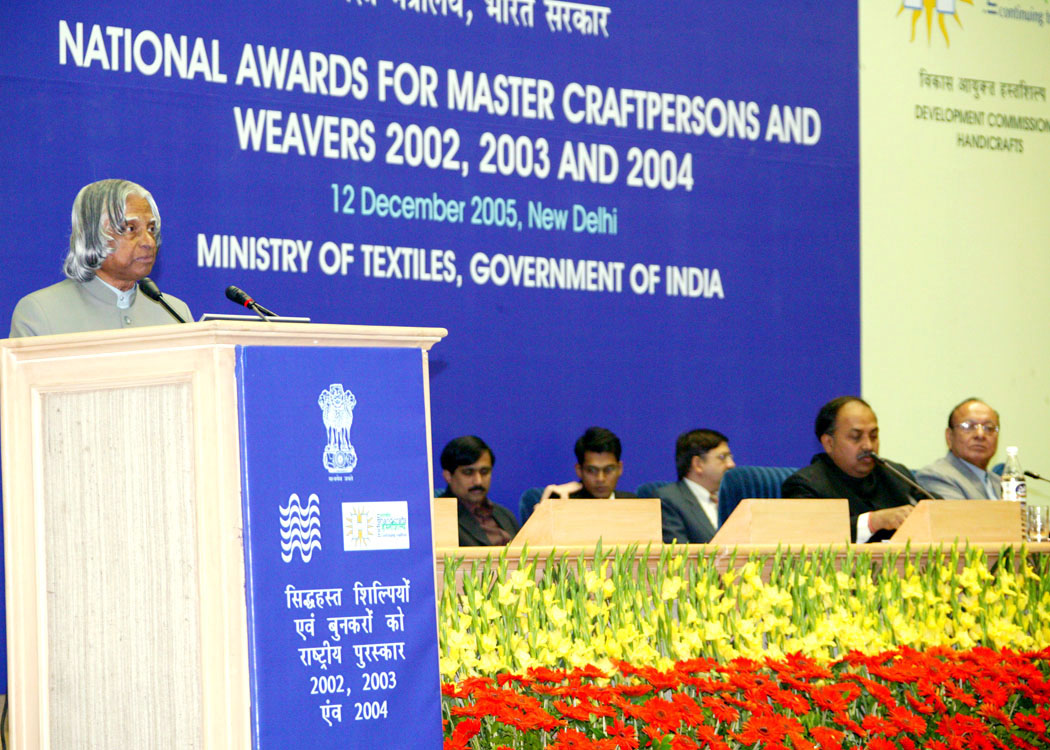

Empowering Handloom weavers
Some of the problems experienced by Handloom weavers are the availability of Yarn material and availability of the markets against the competition from power looms. The advantage for our nation is the potential of handloom sector in providing employment for large number of people in the household and self managed cooperative societies spread across the country. This type of household small enterprises, I have seen in Manipur and Assam. Every member of the house weaves and wears their products. Also, if the handloom cottage industry is properly empowered, it has a potential to become a remunerative employment generator. In spite of competition from power looms, the handloom products are liked due to its unique quality, texture and uniqueness of design. Following are the suggestions for empowering the handloom sector in the country within next five years:
a. Creation of exclusive design centres to promote handloom products with inbuilt know how from the fashion design centres of the country. Design centres can be established in all the regions where handloom work is predominant. Design centres can be created on the lines of Tiruppur Garment design centres.
b. Generation of export and national market through proper business development practices and aggressive advertisement.
c. Elevating the skill of the weavers and upgrading the looms and the processes taking into account, the environmental needs and the international market demand.
d. Creation of an ?India brand? for handloom products through a country wide mission mode project.
e. Ensuring availability of the yarn material at reasonable price to the weavers. Wherever cotton is being cultivated it is better to introduce the best practices of cultivation as has been done in the Gheri Buttar in Punjab, to have a check on the cost of the yarn.
Now, I would like to share with you one experience I had on 10th December 2005.

Cotton Production and Garment Industry
I visited a village called Gheri Buttar near Bhatinda in Punjab, where I met the farmers who have successfully increased the production of seed cotton from four hundred and sixty kilo gram per acre to eight hundred and sixty kilogram per acre in the year 2005. This has been achieved through a productive partnership between farmers, agricultural scientists, textile industry supervisors and the Government by following a scientific approach to farming, adopting pre-harvest and post-harvest techniques with an assured market for seed cotton. I have suggested the farmers in that village to mount a programme of second green revolution in Cotton meaning that instead of selling the cotton produce directly in the market they should convert certain quantity of cotton into yarn, cloth and apparel in the village complex itself and market it in the national and international markets. This is the only way that the income of the farmers can substantially go up.
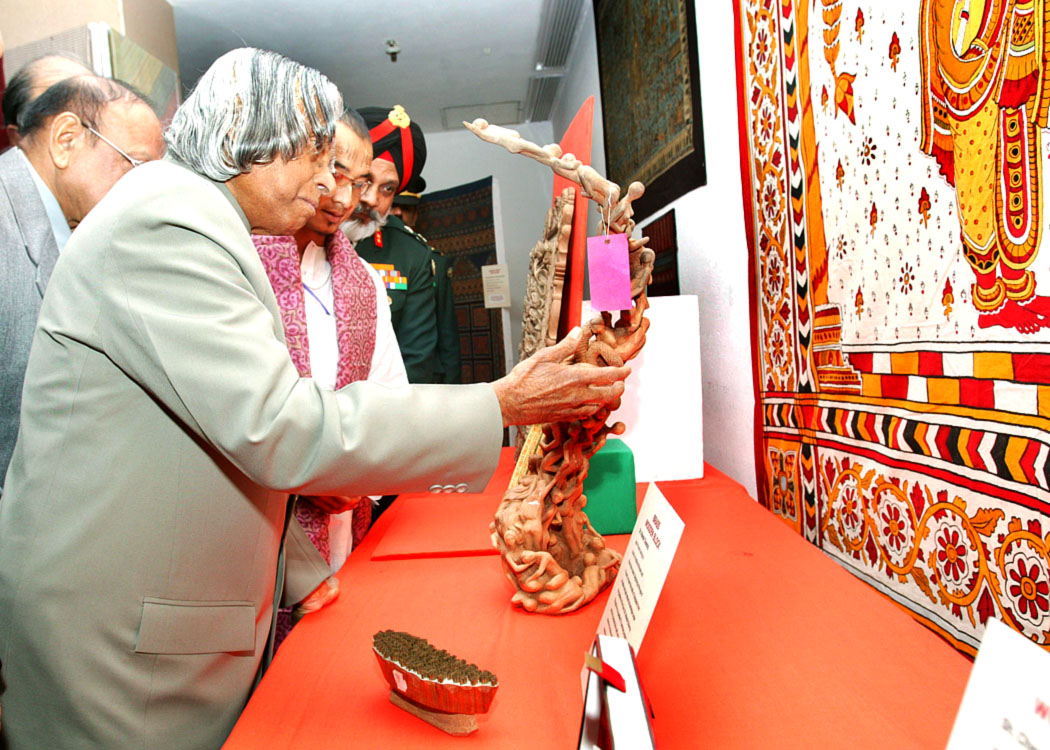
Hence, I would like to link cotton production to yarn, cloth, leading to garment and apparel export business, which is a low investment and large volume employment generator. Two centers are well known Tiruppur in Tamilnadu and Ludhiana in Punjab for garment design to production. India is presently, exporting six billion dollars worth of garments, whereas with the WTO regime in place, we should aim to enhance the production and export of apparel and garments to over 18 billion dollars by 2010. This will need intense collaboration between master weavers in the villages, NIFT, Textile Research Associations, Cotton Research Association, textile industrialists and the government. A mission mode programme should emerge. This will also be a large-scale generator of employment particularly in the rural areas. By tripling the export of apparels, we can add more than 5 million direct jobs and 7 million indirect jobs in allied sector by diversifying the handloom sector into apparel and other usages such as bandage cloth. This will give employment potential particularly for some portion of handloom weaving community and enrich the task in providing quality apparel to the national and international clientele. Concerted effort is needed in Cotton research, technology generation, transfer of technology, modernization and upgrading of ginning and pressing factories and aggressive marketing strategy. NIFT can definitely assist in embedding fashion in our handloom industry so that Indian handloom products from yarn to garments carry innovative ideas for the final fashion with enhanced value. Let me now discuss about the handicrafts sector.
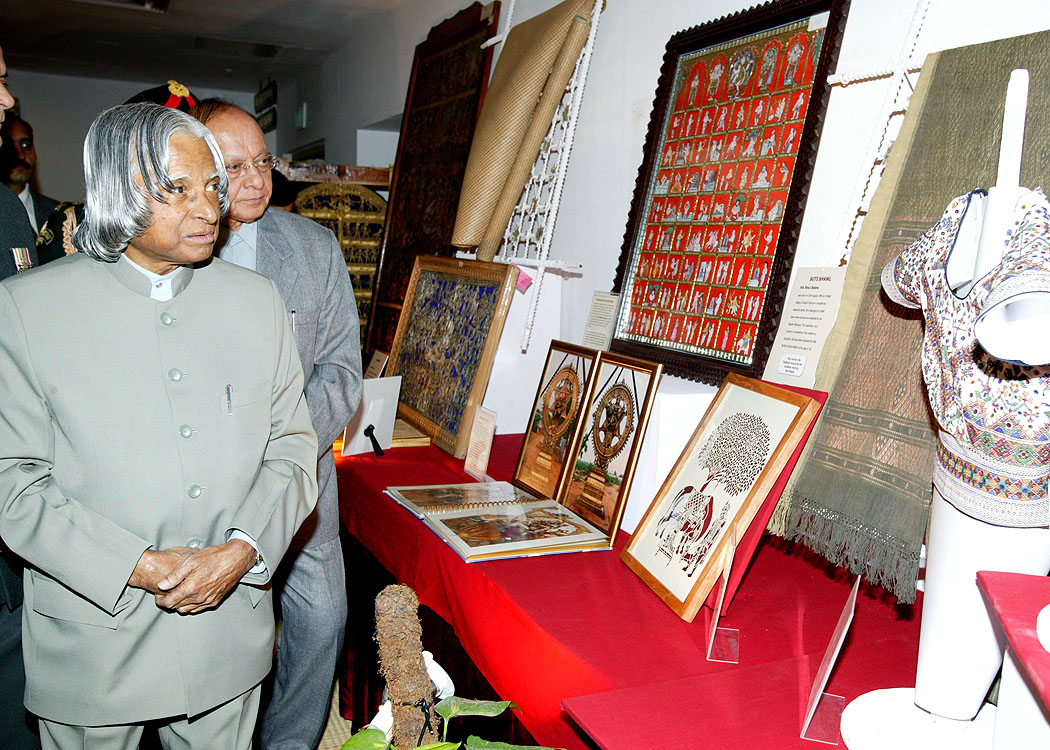

Focus Handicrafts sector
I had a beautiful experience of some of the art products and the men behind the products with all of you.
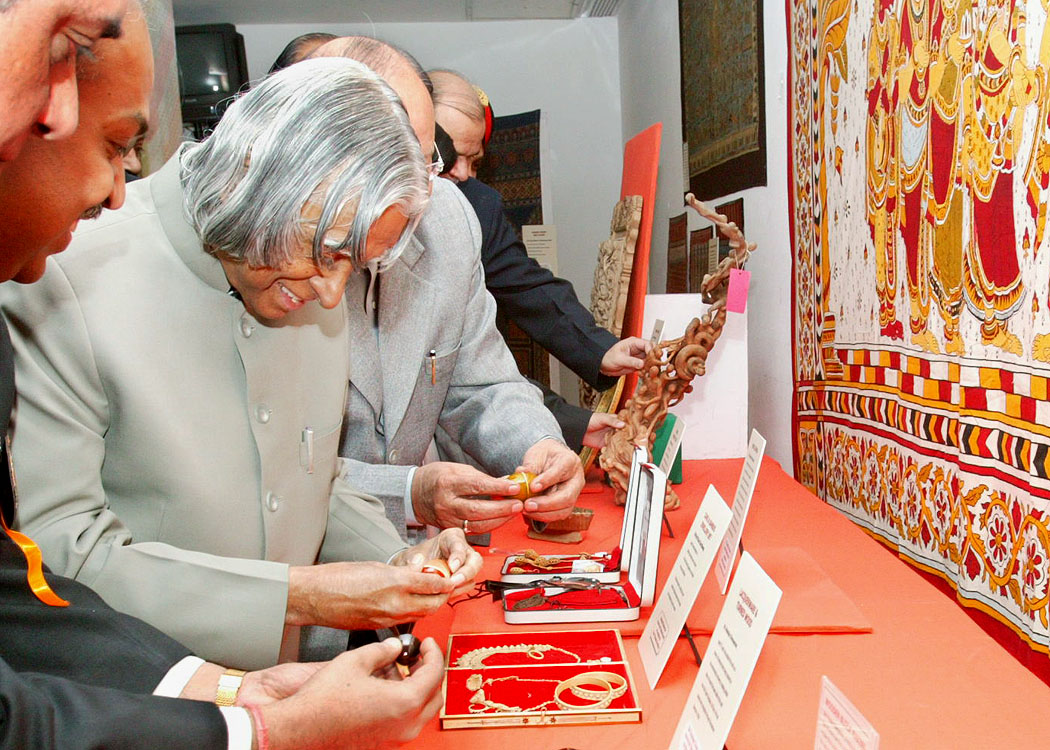
Bhadohi Carpet : Some time back, Smt Jaya Jaitly who is promoting Indian crafts wrote to me about the talented carpet weaver from Bhadohi in Uttar Pradesh named Ramjeet Bind. She mentioned in her letter that Shri Ramjeet Bind has broken all the records in making finely knotted carpets. He was at that time demonstrating weaving and selling his durries at Delhi HAAT. She wanted to bring Shri Ramjeet Bind to me who had woven a carpet embossed with an interesting image. I agreed to her request and on 1st January 2004 Shri Ramjeet came to me with the framed carpet specimen along with Smt Jaya Jaitly. When I saw the carpet, I was overjoyed with the craftsmanship and the realism he had brought in weaving it. I asked him how much time it took for making this carpet. He said it took nearly three to four weeks for knotting the carpets. I asked him what would be its price. He told me that it was priceless since his whole heart and soul has gone into the creation of this work. When I had a re-look at the carpet, I saw that it was really so. Such is the dedication, commitment and interest shown by many of our weavers and crafts persons engaged in Dastkari work in our country. Since I am in the midst of crafts persons and artisans I thought of sharing with you this incident which really touched my heart. The second incident is about the Sirki Art.
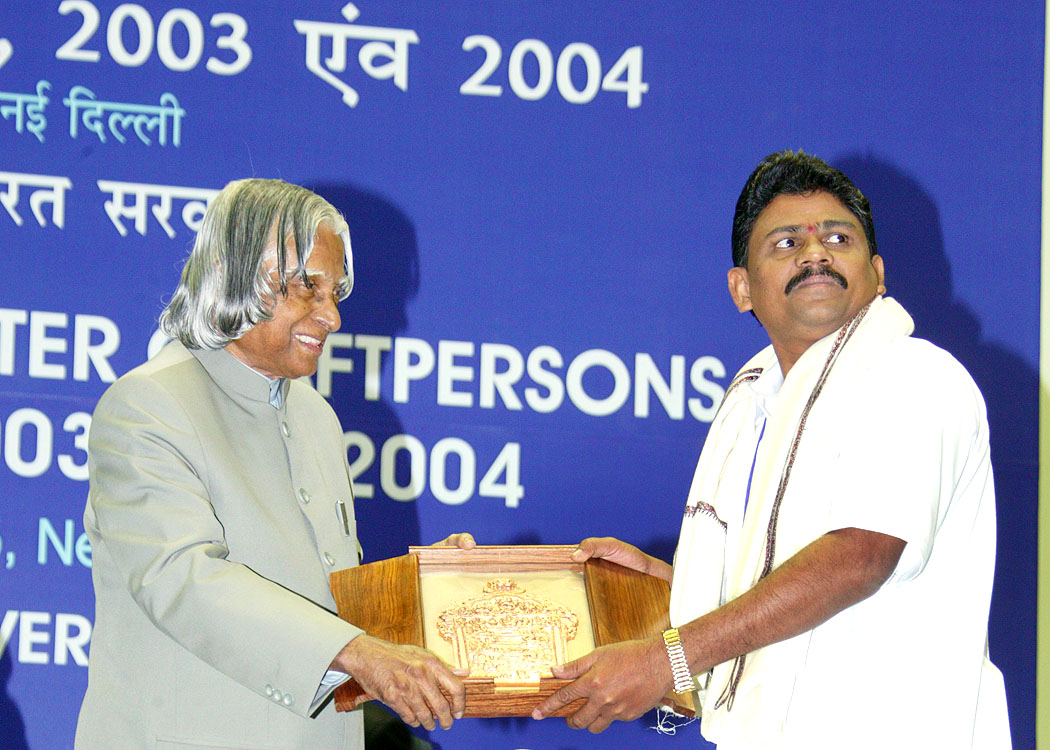
Sirki Art : One day a craftsman landed in Rashtrapati Bhawan and wanted to see me. I agreed. His name was Shri Mohammed Sageer Mansoori. He belonged to Kasganj, Etah (Uttar Pradesh). He said that he had a special gift of making paintings using Sirki leaves available in the forest. This gift was with him right from his early childhood. He goes to the forest, collects the leaves, presses them in a special fashion so that the insects do not attack and then he sequentially organizes the leaves on hard surface and pastes them using fevicol or dentroid. He showed me few paintings which he has made including a view of the Kutub Minar which was really beautiful. He creates beautiful images and I was fully impressed with the quality of his paintings. He uses certain techniques to enhance the shelf life of his paintings which is around ten years. He told me that he normally takes around a week for completing one painting. The problem he faces is in the marketing of his paintings in the villages. He also needs help in increasing the longevity of his paintings. Both crafts work are indeed excellence in art. Let me talk to you some of the present day architectural creations, which touched my heart.
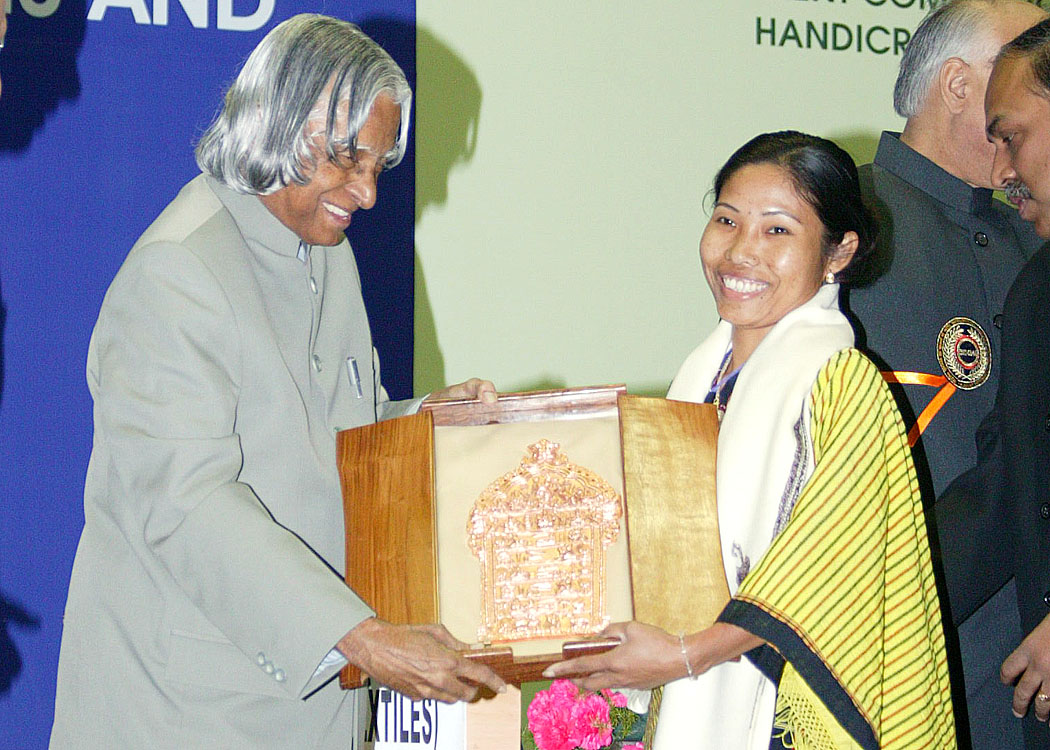

Present time architectural creations
India is indeed famous for sculptors with architectural marvels. Recently I have seen two great sculptor works of architectural creations in two places. On 6th Nov 2005, I dedicated the Akshardham cultural complex in NewDelhi. Pramukh Swamiji Maharaj has inspired thousands of people across the country and abroad and brought together the best of the minds for creating a beautiful cultural complex. It has become a place of education, experience and enlightenment. It creatively blends the traditional stone art and architecture, Indian culture and civilization, ancient values and wisdom and the best of modern media and technology. Multiple layers of this complex expresses the strength of the mind, willpower of the human being, indomitable spirit, flowering kindness, fusion of scientific and medical talent, myriad colors of varied cultures and ultimately the power of knowledge. In essence, it is a dynamic complex with lively images of 20,000 sculptors designed and made by special artisans involving 300 million man hours of work. I am also reminded of the beautiful sculptural work being done at the Kala-bhai-ravar temple at Adhichunchanagiri. It was indeed a spiritual delight. The sculptors at work in Adhichunchanagiri had come from South India. Such architectural complexes always stand out for the excellence of Indian craftsmanship.
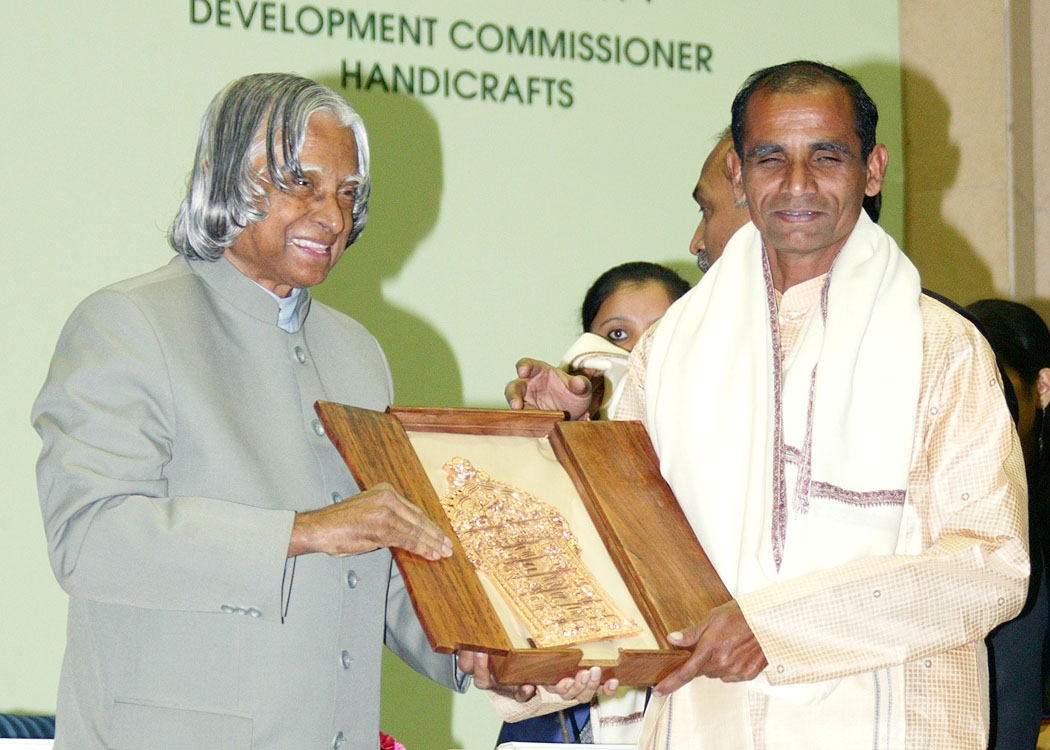

Knowledge powered rural complex
The work of craftspeople and artisans is the result of creativity. This creativity comes from traditional knowledge. The crafts products from this traditional knowledge are of constant attack from urban industrial and multinational products (e.g. palm leaf, coir and rubber products versus plastic products). The traditional knowledge is in isolation in rural environment. This traditional knowledge has to be integrated with technology with value addition and pro-active co-operative societies to empower craftspeople and artisans, making avenues for direct marketing/selling. Instead of craftspeople coming to urban marketing centres, the reverse phenomena have to take place. How is it possible? I have a suggestion triggered by Visvakarma?s Children. I would recommend the young graduates coming from the National Institute of Fashion Technology and Sculptors and Architectural institutions to create small and medium enterprises in the seven thousand PURA complexes planned in different parts of the country based on the core competence of the crafts people available locally in each of the PURA complex. This will enable preservation of our traditional knowledge and also promotion of products at an attractive price in the national and international market through value addition. Marketing has to be arranged through internet and exhibitions in marketing complexes such as Delhi HAAT.
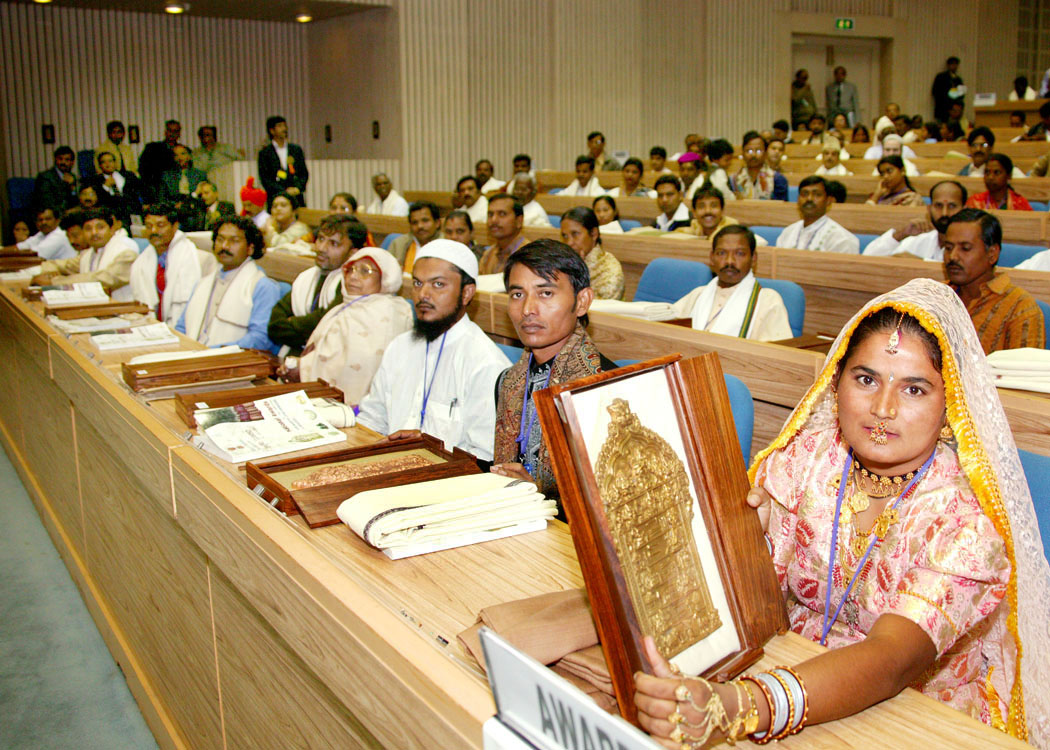

Conclusion: Mission to create Heritage Cave
When we look at our civilizational heritage, it is an integrated history of culture, people's way of living in various parts of the country and the evolution of an integrated Indian society. Since I am in the midst of a powerful creative audience I would like to share a thought with you. This thought I got, after visiting the Ajantha and Ellora caves, Mahabalipuram Pallava sculpture and many of our ancient temples which have preserved the very important sculptures and paintings with out the names of the source and the date on which it is created. The history of some of our civilizational heritage, paintings and sculpture which are misplaced are to be recreated. I would suggest that the Ministry of Textile in collaboration with the Ministry of Culture and many art lovers and crafts persons can take up the mission of creating a Heritage Cave in the hill region in the backdrop of mountains. In this cave, 5000 years of our cultural heritage, paintings and sculpture should be recreated with the knowledge base available in literature and with cultural historians. It could be a mission for the decade for all our best crafts persons in the country who can create the paintings and sculpture of yesterday, today and tomorrow. This Heritage Cave should be the place where the past meets the present and creates the future. This will definitely become a place of attraction for all the national and international tourists including researchers of art and culture.
Once again let me congratulate all the award winners and my best wishes to all the crafts persons and weavers in their mission of enriching our culture and creating value added products to the society.
May God bless you.
<<Back
|
|